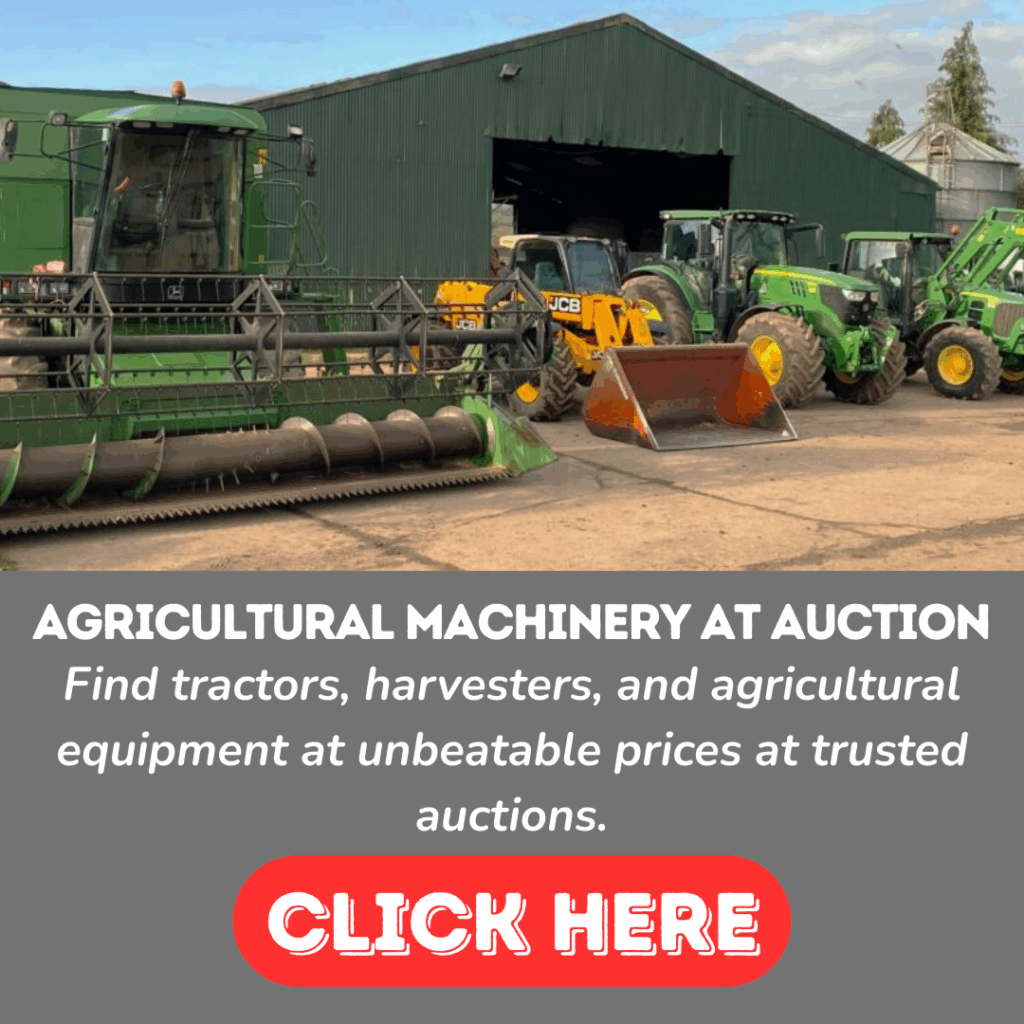Where to find Agricultural machinery and equipment auctions in the United States and how they work
You want capable gear at a price that helps your bottom line.
Agricultural machinery and equipment auctions across the United States — on national online platforms, local sale barns, and bank or government liquidations — are where you’ll find tractors, combines, planters, loaders, robotic milkers, irrigation pivots, and more.
Know where to look and how sales run so you avoid overpaying or buying a lemon.

Major online platforms for Agricultural machinery and equipment
Large auction houses and marketplaces list thousands of items each month and let you bid from your phone or desktop. Key names to watch:
- Ritchie Bros — large fleets, live and timed events, onsite inspections.IronPlanet — timed auctions, certified condition reports.BigIron, Proxibid, AuctionTime — regional farm equipment focus and dealer listings.GovDeals, GSA Auctions, US Marshals — government and seized or surplus equipment.
- MachineryTrader, EquipmentFacts — heavy and specialty machinery.
What to expect: photos, spec sheets, condition reports, registration deposits, and buyer premiums. Compare fees, pickup options, and whether the platform supports local pickup to reduce transport costs.
Local, bank, and government auctions for Agricultural machinery and equipment
Local sale barns, county sheriff sales, bank repossessions, and state/federal surplus auctions can yield bargains:
- County tax and sheriff sales often list equipment with no warranties.Banks, Farm Credit, and credit unions sell repossessed, often late-model machines.USDA, state agencies, and GSA list surplus and seized items; expect strict removal and payment rules.
- Bankruptcy and dealer liquidations can surface fleets and parts.
Always check sale notices, titles, removal windows, and whether items are sold as-is.
How to register, check lot lists, and confirm auction dates before you bid
Register early and review the lot list:
- Sign up on the auction platform with ID, contact details, and tax info.Expect deposits or card holds to activate bidding.Save lot lists, study photos and condition notes, and note inspection times.Confirm auction and pickup dates with the house a day or two beforehand.
- Learn buyer premiums, taxes, acceptable payment methods (wire, certified check), and removal penalties.
Use absentee or phone bids if you can’t attend. If new to an auction house, start with small lots to learn pace and clock extensions.
Automated harvesting machines and robotic milking systems at auction
Automated harvesters (smart combines, specialty fruit harvesters) and robotic milking systems can cut labor and increase uptime. Auctions often offer demo or leased units at lower cost — but tech and service history matter.
What to check:
- Service logs, software versions, and update history.Sensor and camera condition.Moving parts: belts, bearings, hydraulics.
- On robots: vacuum pumps, liners, milking cup condition, and calibration.
Buy units with clear support options and factor in parts, software fees, and potential service calls.
Time-saving benefits and inspection priorities
- Automation reduces manual adjustments, overlap, and idle time.Robots provide consistent milking intervals and herd health data.
- Inspect electronics for corrosion, check cables, test live demos when possible, and review past invoices for recurring faults.
How precision seeding equipment and no‑till planters cut costs when you buy Agricultural machinery and equipment
Precision planters and no‑till systems reduce seed waste, fuel, and labor. Auctions let you upgrade at lower cost, but condition and compatibility matter.
Performance checks:
- Seed meter type (vacuum, pneumatic) and singulation performance.Row units, discs, coulters, and closing wheels.ISOBUS or proprietary controls and monitor compatibility.
- Wear parts and spare availability.
Pair precision seeding with variable-rate tech for maximum input savings and yield consistency.
Key advantages
- Singulation and section control reduce doubles and overlaps.Hydraulic/electric drives allow on-the-fly population changes.
- No‑till preserves soil, lowers fuel use, and reduces erosion when residue management features are appropriate.
Why fuel‑efficient tractors and multi‑function compact loaders reduce your operating costs at auction
Modern, well-maintained tractors and compact loaders save fuel and replace multiple machines on the yard. At auction you can find late-model, fuel-efficient units below new price — verify records first.
Check:
- Fuel-use logs, idle hours, and telematics if available.Engine and transmission service history (CVT, powershift care).Hydraulic flow, auxiliary circuits, and quick-attach standardization.
- Hours vs. visual wear, tire/track condition, and attachment wear.
A compact loader with standard quick-attach compatibility expands attachment options and lowers overall fleet cost.
How GPS‑guided farm machinery, telematics, and variable‑rate applicators boost efficiency
Guidance, telematics, and VRA cut overlap, prevent breakdowns, and apply inputs only where they pay.
Verify before you buy:
- Software versions, transferable licenses, and field map compatibility.Data logs showing fault history, idle time, and usage patterns.Sensor calibration (flow meters, yield monitors), antenna and wiring condition.
- Whether cab displays and ISOBUS profiles match your existing systems.
Telematics helps schedule maintenance and optimizes logistics; VRA requires accurate maps and functional control valves to deliver ROI.
Practical auction tips: transport, finance, irrigation, and after‑purchase steps for Agricultural machinery and equipment
Plan transport and payment before you bid:
- Book haulers early, supply exact dimensions/weights, and budget permits, escorts, and state-by-state routing.Get pre-approval from banks, Farm Credit, or equipment finance companies; factor buyer premiums into loan size.For irrigation pivots and large spans, include dismantle/reassembly and specialized crews in costs.
- Have funds ready (wires clear fastest) and understand pickup windows and storage penalties.
After purchase:
- Obtain the invoice and removal instructions.Schedule a post-purchase inspection/service within the first week.
- If you can’t inspect, hire a local mechanic or tech to perform a prepurchase checklist.
Pre‑purchase inspection checklist for Agricultural machinery and equipment
Use this condensed checklist before bidding or immediately after winning:
- Titles and paperwork: clear title, lien status, VIN/serial numbers.Engine: compression, leaks, oil condition, service records.Transmission and hydraulics: smooth operation, leaks, service history.Electronics/tech: software versions, sensor tests, telematics logs.Wear parts: belts, bearings, coulters, seed meters, liners.Tires/tracks, attachments, quick-attach locks.Physical dimensions and transport requirements.
- Removal window, pickup location, and auction house terms (fees, taxes).
If buying tech-heavy gear, demand logs and confirm license transferability.
Final checklist to win value at Agricultural machinery and equipment auctions
- Research platforms and local sales; set maximum bids that include buyer premiums, transport, and repairs.Register early, read terms, and confirm pickup windows.Inspect or hire an inspector; prioritize service records and software history.Book hauling and finance in advance.
- Start small to learn the auction rhythm, then scale up confidently.
With a clear plan, auctions are one of the best places to secure Agricultural machinery and equipment at competitive prices — but success depends on inspection, logistics, and knowing the true total cost before you bid.

